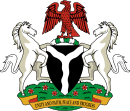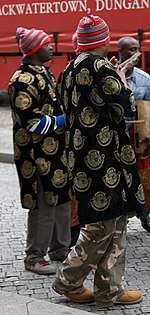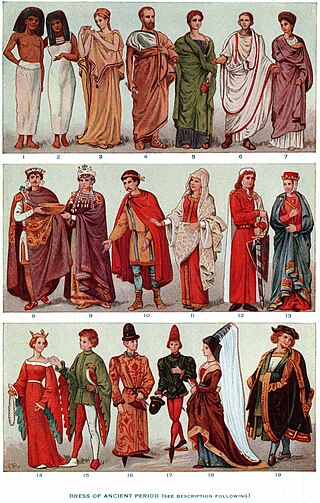
Clothing is any item worn on the body. Typically, clothing is made of fabrics or textiles, but over time it has included garments made from animal skin and other thin sheets of materials and natural products found in the environment, put together. The wearing of clothing is mostly restricted to human beings and is a feature of all human societies. The amount and type of clothing worn depends on gender, body type, social factors, and geographic considerations. Garments cover the body, footwear covers the feet, gloves cover the hands, while hats and headgear cover the head, and underwear covers the private parts.

A folk costume expresses a national identity through clothing or costume, which is usually associated with a specific region or period of time in history. It can also indicate social, marital, or religious status. If the costume is used to represent the culture or identity of a specific ethnic group, it is usually known as ethnic costume. Such costumes often come in two forms: one for everyday occasions, the other for traditional festivals and formal wear. The word "costume" in this context is sometimes considered pejorative due to the multiple senses of the word, and in such cases "clothing", "garments" or "regalia" can be substituted without offense.
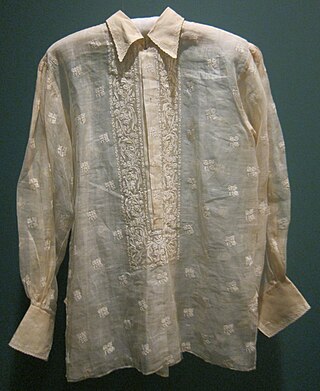
The barong tagalog, more commonly known simply as barong, is an embroidered long-sleeved formal shirt for men and a national dress of the Philippines. Barong tagalog combines elements from both the precolonial native Filipino and colonial Spanish clothing styles. It is traditionally made with sheer textiles (nipis) woven from piña or abacá; although in modern times, cheaper materials like organza silk, ramie or polyester are also used.

African clothing is the traditional clothing worn by the people of Africa.

Kurdish traditional clothing is a historical and contemporary aspect of Kurdish heritage.
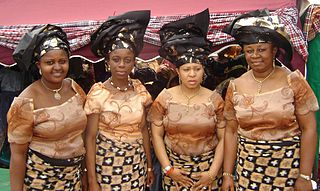
The wrapper, lappa, or pagne is a colorful garment widely worn in West Africa by both men and women. It has formal and informal versions and varies from simple draped clothing to fully tailored ensembles. The formality of the wrapper depends on the fabric used to create or design it.

Clothing in Afghanistan consists of the traditional style of clothing worn in Afghanistan. The various cultural exchanges in the nation's history have influenced the styles and flavors of contemporary Afghan designs. The national dress is the fusion of different ethnic groups in Afghanistan. The styles can be subdivided into the various ethnicities with unique elements for each. Traditional dresses for both men and women tend to cover the whole body, with trousers gathered at the waist, a loose shirt or dress, and some form of head covering.
Maya textiles (k’apak) are the clothing and other textile arts of the Maya peoples, indigenous peoples of the Yucatán Peninsula in Mexico, Guatemala, Honduras, El Salvador and Belize. Women have traditionally created textiles in Maya society, and textiles were a significant form of ancient Maya art and religious beliefs. They were considered a prestige good that would distinguish the commoners from the elite. According to Brumfiel, some of the earliest weaving found in Mesoamerica can date back to around 1000-800 B.C.E.
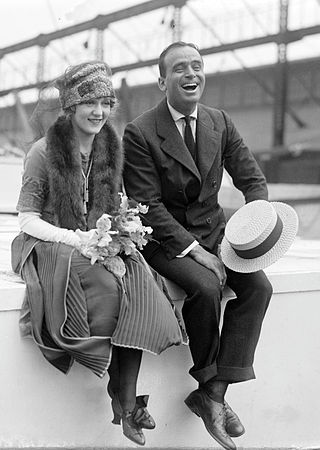
Western fashion in the 1920s underwent a modernization. For women, fashion had continued to change away from the extravagant and restrictive styles of the Victorian and Edwardian periods, and towards looser clothing which revealed more of the arms and legs, that had begun at least a decade prior with the rising of hemlines to the ankle and the movement from the S-bend corset to the columnar silhouette of the 1910s. Men also began to wear less formal daily attire and athletic clothing or 'Sportswear' became a part of mainstream fashion for the first time.

Pakaian is the term for clothing in Malaysia's national language. It is referring to things to wear such as shirts, pants, shoes etc. Since Malaysia is a multicultural nation: Malay, Chinese, Indian and hundreds of other indigenous groups of Malay Peninsula and Borneo, each has its own traditional and religious articles of clothing all of which are gender-specific and may be adapted to local influences and conditions. Previously, traditional clothes were worn daily. However, by excluding Baju Melayu, Baju Kurung many are now only worn on special occasions such as marriage ceremonies and cultural events.

Outside Western cultures, men's clothing commonly includes skirts and skirt-like garments; however, in the Americas and much of Europe, skirts are usually seen as feminine clothing and socially stigmatized for men and boys to wear, despite having done so for centuries. While there are exceptions, most notably the cassock and the kilt, these are not really considered 'skirts' in the typical sense of fashion wear; rather they are worn as cultural and vocational garments. People have variously attempted to promote the fashionable wearing of skirts by men in Western culture and to do away with this gender distinction.

Chinese clothing includes the traditional hanfu and garments of ethnic minorities, as well as modern variations of indigenous Chinese dresses. Chinese clothing has been shaped through its dynastic traditions, as well as through foreign influences. Chinese clothing showcases the traditional fashion sensibilities of Chinese culture traditions and forms one of the major cultural facets of Chinese civilization.

Khmer traditional clothing.

Aso oke fabric, is a hand-woven cloth created by the Yoruba people of west Africa. Usually woven by men and women, the fabric is used to make men's gowns, called agbada and hats, called fila, as well as women's wrappers, called iro and head tie, called gele.

The national costume of Indonesia is the national attire that represents the Republic of Indonesia. It is derived from Indonesian culture and Indonesian traditional textile traditions. Today the most widely recognized Indonesian national attires include batik and kebaya, although originally those attires mainly belong within the island of Java and Bali, most prominently within Javanese, Sundanese and Balinese culture. Since Java has been the political and population center of Indonesia, folk attire from the island has become elevated into national status.

Aso ebi (Yoruba), sometimes spelled as asoebi in Nigeria and ashobie in Sierra Leone and the Gambia, is a uniform dress or dressing code/style that is traditionally worn by the Yoruba People and acculturized by some other African cultures, is an indicator of cooperation, camaraderie and solidarity during ceremonies, events and festive periods. The purpose of wearing the dress can be to serve as self-identification with age mates, relatives or friends during social occasions or funerals.
Clothing in Myanmar varies depending on the ethnicity, geography, climate and cultural traditions of the people of each region of Myanmar (Burma). The most widely recognized Burmese national costume is the longyi, which is worn by both males and females nationwide. Burmese clothing also features great diversity in terms of textiles, weaves, fibers, colours and materials, including velvet, silk, lace, muslin, and cotton.
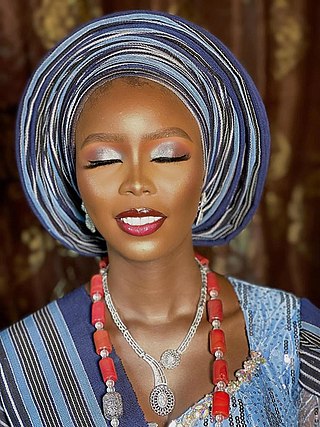
Gele is a traditional head tie native to Yoruba women. The gele comes in specific shapes and designs. Gele is worn with other Yoruba women's outfits, like Iro ati buba, Komole and Asoebi.

Most Sudanese wear either traditional or western attire. A traditional garb widely worn by Sudanese men is the jalabiya, which is a loose-fitting, long-sleeved, collarless ankle-length garment also common to Egypt. The jalabiya is often accompanied by a large turban and a scarf, and the garment may be white, coloured, striped, and made of fabric varying in thickness, depending on the season of the year and personal preferences.

Yoruba women’s clothing is the traditional attire worn by women of the Yoruba ethnic group in parts of Nigeria, Benin and Togo in a region called Yorubaland. The clothing reflects the rich culture, history and aesthetic preferences of the Yoruba people.

